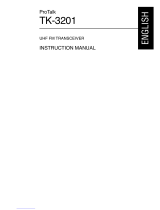
iii
CONTENTS
UNPACKING AND CHECKING EQUIPMENT ......................... 1
SUPPLIED ACCESSORIES .......................................................... 1
ORIENTATION ......................................................................... 2
DISPLAY ................................................................................ 3
PREPARATION ........................................................................ 4
INSTALLING/ REMOVING THE BATTERY PACK ............................... 4
INSTALLING/ REMOVING BATTERIES ........................................... 5
CHARGING THE BATTERY PACK ................................................ 6
INSTALLING/ REMOVING THE BELT HOOK .................................... 8
INSTALLING/ REMOVING OPTIONAL ACCESSORIES ........................ 8
GETTING STARTED ................................................................ 9
QUIET TALK/ DIGITAL QUIET TALK ..................................... 11
SCANNING THE CHANNELS ............................................... 13
REVERT CHANNEL ................................................................ 15
MONITORING A CHANNEL .................................................. 16
VOICE ACTIVATED CONTROL (VOX) .................................. 17
VOX GAIN ......................................................................... 17
VOX DELAY TIME ................................................................ 18
VOX OPERATION ................................................................. 19
VOX BUSY LOCKOUT ........................................................... 20
PRIVACY TALK ...................................................................... 21
OPERATING FEATURES ....................................................... 22
TRANSMISSION POWER .......................................................... 22
KEY LOCK ........................................................................... 22
SUPER LOCK ....................................................................... 23
LAMP .................................................................................. 24
TIME-OUT TIMER .................................................................. 24
BATTERY SAVE ..................................................................... 26
BATTERY INDICATOR .............................................................. 27





















